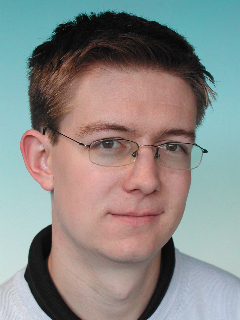Old list of all students
Please maintain the list in Alphabetical order.
A
| Picture
| Name
| Room
| Phone
| Supervisor
| Thesis Topic
| Abstract
|
|
| Rene Andrae
|
|
|
|
|
|
B
| Picture
| Name
| Room
| Phone
| Supervisor
| Thesis Topic
| Abstract
|
|
| Carolina Bergfors
| 323
| 473
| Prof. Thomas Henning, Dr. Wolfgang Brandner
|
|
|
|
| Marc-Andre Besel
| 112
| 422
| Dr. Oliver Krause
| Supernova light echos as a probe to supernova physics and the ISM
|
|
|
| Paul Boley
|
|
|
|
|
|
|
| Crystal Brasseur
|
|
|
|
|
|

| Leonard Burtscher
| 308/3
| 405
| Dr. Klaus Meisenheimer
| Resolving the central dust structure in nearby Seyfert galaxies
| To further test the unified model of Active Galactic Nuclei, the properties of the dusty torus, which encapsulates the central engine, need to be determinded. In this project, the interferometric observation of tori of active galaxies (e.g. PhD thesis Tristram et al., 2007) will be extended to more than the few sources currently available. Those data will then be compared to model calculations to gain insights into e.g. the geometry and clumpiness of AGN tori. The measurements will be carried out using the MIDI instrument at the VLTI on Cerro Paranal and will be compared to radiative transfer and hydrodynamical models (e.g. PhD thesis Schartmann et al., 2007).
|
C
D
| Picture
| Name
| Room
| Phone
| Supervisor
| Thesis Topic
| Abstract
|
|
| Nicola Da Rio
| A 10
|
| Prof. Thomas Henning, Dr. Dimitrios Gouliermis
|
|
|
|
| Gisella De Rosa
| 133
| 266
|
|
|
|
|
| Kai-Martin Dittkrist
|
|
|
|
|
|
|
| Karsten Dittrich
| 216b
| 384
| Dr. Hubert Klahr
| Gravoturbulent Planetesimal Formation in the Early Solar System
|
|
F
| Picture
| Name
| Room
| Phone
| Supervisor
| Thesis Topic
| Abstract
|
|
| Min Fang
| 224
| 335
| Prof. Thomas Henning, Dr. Roy Van Boekel
|
|
|
|
| Michael Fiedler
|
|
|
|
|
|
|
| Mario Flock
| 037
| 237
|
|
|
|
|
| Roman Follert
| 037
| 237
| Dr. Tom Herbst
|
|
|
G
| Picture
| Name
| Room
| Phone
| Supervisor
| Thesis Topic
| Abstract
|
|
| Jianling Gan
| 126
| 258
|
|
|
|

| Mario Gennaro
| 224
| 294
| Prof. Thomas Henning, Dr. Wolfgang Brandner
| IMF of Young Clusters
|
|
H
| Picture
| Name
| Room
| Phone
| Supervisor
| Thesis Topic
| Abstract
|
|
| Gerhard Hoffmann
|
|
|
|
|
|

| Rory Holmes
| 112
| 436
| Dr. Oliver Krause
|
| Near-Infrared Imaging Channel for the Euclid Dark Energy Mission - Development of Critical Optomechanical Components and an Instrument Calibration Concept
|
|
| Felix Hormuth
| 114
| 221
|
|
|
|
J
| Picture
| Name
| Room
| Phone
| Supervisor
| Thesis Topic
| Abstract
|

| Mathias Jäger
| 233
| 349
| Dr. Klaus Meisenheimer
| Evolution of SED galaxies at high redshift observed with COMBO17+4
| With the COMBO17+4 survey it is possible to get photometric redshifts for thousends of objects. Therefore the evolution of galaxies in the red sequence and the blue cloud can be analyzed, excluding cosmological variances. Additionally a catalogue for all identified galaxies, including their SED type, is made. Follow up observations of special objects in the sample are possible.
|
K
| Picture
| Name
| Room
| Phone
| Supervisor
| Thesis Topic
| Abstract
|
|
| Alexander Karim
| 326
| 413
| Dr. Eva Schinnerer
|
|
|
|
| Natalia Kudryavtseva
| 225
| 203
| Prof. Thomas Henning, Dr. Wolfgang Brandner
|
|
|
L
| Picture
| Name
| Room
| Phone
| Supervisor
| Thesis Topic
| Abstract
|
|
| Ronald Laesker
|
|
|
|
|
|
M
| Picture
| Name
| Room
| Phone
| Supervisor
| Thesis Topic
| Abstract
|
|
| Jesus Maldonado
| 037
|
|
|
|
|
|
| Helen Morrison
| 037
| 237
| Hubert Klahr
|
|
|
|
| Maximiliano Moyano
| 308/4
| 219
|
|
|
|
|
| André Müller
| ESO
| 089 32006224
| Thomas Henning, Ralf Launhardt, Francoise Delplancke
| Binarity and disk structure of Herbig Ae and Be stars
|
|
N
| Picture
| Name
| Room
| Phone
| Supervisor
| Thesis Topic
| Abstract
|
|
| Somayeh Nezami
|
|
|
|
|
|
|
| Nikolay Nikolov
| A 10
| 438
|
|
|
|
|
| Dading Nugroho
| 225 A
| 203
| Dr. Knud Jahnke
| Star formation properties and kinematics of nearby AGN host galaxies
|
|
P
| Picture
| Name
| Room
| Phone
| Supervisor
| Thesis Topic
| Abstract
|

| Jan Pitann
| 225
| 203
| Dr. Oliver Krause
| Early stages of massive star formation
|
|
|
| Oliver Porth
| 133
| 315
| Dr. Christian Fendt
| Relativistic AGN Jet formation
|
|
R
| Picture
| Name
| Room
| Phone
| Supervisor
| Thesis Topic
| Abstract
|
|
| Natalie Raettig
| 133
| 315
| Dr. Hubert Klahr
| Hydrodynamical Simulations for Planet-Formation
|
|
|
| Balasubramian Rakumar
|
|
|
|
|
|

| Boyke Rochau
| 308/1
| 400
| Dr. Wolfgang Brandner
| Internal Dynamics of Galactic starburst clusters
| TBD
|
|
| Christine Ruhland
| 124
| 257
| Dr. Eric Bell
| Understanding the assembly of disk galaxies
| The stellar halos of galaxies contain a lot of information about
the assembly of galaxies owing to their long dynamical times and the
relative absence of in-situ star formation. Substructures in the halo give
important hints of accretion and merger events and enable us to study the
role these events played in forming the Milky Way halo.
|
S
| Picture
| Name
| Room
| Phone
| Supervisor
| Thesis Topic
| Abstract
|
|
| Jascha Schewtschenko
| 037
|
| Dr. Andrea Maccio
|
|
|

| Markus Schmalzl
| A10
| 392
| Prof. Thomas Henning, Dr. Ralf Launhardt
| The earliest stages of low-mass star formation
| This thesis focuses on low-mass star formation on different scales. One goal is to see the largescale environment around isolated prestellar cores. The second and main topic of my work is to analyze the prestellar collapse and fragmentation of Bok Globules by means of mm-interferometry.
|
|
| Kasper Borello Schmidt
| 234 A
| 226
| Prof. Hans Walter Rix
|
|
|
|
| Andreas Schruba
| 324
| 465
| Fabian Walter
| Star Formation and the Interstellar Medium in Nearby Galaxies
|
|

| Tim Schulze-Hartung
| A5
| 357
| Prof. Thomas Henning, Dr. Ralf Launhardt
|
|
|
|
| Bernhard Sturm
| 216 B
| 383
|
|
|
|
T
| Picture
| Name
| Room
| Phone
| Supervisor
| Thesis Topic
| Abstract
|
|
| Jochen Tackenberg
| 324
| 462
| Priv. Dozent Dr. Henrik Beuther
| The Early Evolution of High-Mass Star Formation
| The formation of massive stars is still a major but unsolved issue. Within
this, the time-scales of the different evolutionary stages can put
constraints on the processes and mechanisms involved.
To tackle/address this question, galactic plane surveys from the IR to the
radio regime are correlated and on 30sq deg, a statistical study on
high-mass star forming regions will be conducted. In particular, not only the SPITZER surveys GLIMPSE and MIPSGAL, but also ATLASGAL (sub-mm continuum) and CORNISH (cm continuum) will be employed.
|
U
| Picture
| Name
| Room
| Phone
| Supervisor
| Thesis Topic
| Abstract
|
|
| Ana Uribe
| 308/3
| 404
| Prof. Thomas Henning, Dr. Hubert Klahr
| Planet-disk interaction and planet migration.
|
|
V
| Picture
| Name
| Room
| Phone
| Supervisor
| Thesis Topic
| Abstract
|
|
| Bhargav Vaidya
| 224
| 294
| Dr. Christian Fendt
| Theory of Outflows from Massive Stars
| Massive stars play a vital role in the dynamical evolution of clusters in which they are the major source of heavy elements and UV radiation. During their short life time, they undergo a number of physical processes like winds, photo evaporation, jet like outflows, expanding H II regions and supernova explosions. Outflows from these massive stars are ubiquitous and are observed for stars having wide range in luminosity and age. Observations of large number of massive star forming regions, predict a rather simple and self explanatory picture of the outflow evolution, however, the real physical understanding is missing.
Are these massive jet like outflows magneto-centrifugally driven? What kind of interaction is present between the disc and jet? If magnetic fields are important, where do they come from?
In my thesis I will work on the theory of these outflows from massive accretion disc including simulations to investigate physical processes behind the simple outflow evolutionary picture can be understood
|
|
| Tessel van der Laan
| 133
|
| Dr. Eva Schinnerer
|
|
|
|
| Vasyunina Tatiana
| 326
| 459
|
|
|
|
W
| Picture
| Name
| Room
| Phone
| Supervisor
| Thesis Topic
| Abstract
|
|
| Hsiang-Hsu Wang
| 324
| 465
|
|
|
|
Z
| Picture
| Name
| Room
| Phone
| Supervisor
| Thesis Topic
| Abstract
|
|
| Mathias Zechmeister
| 024
| 434
|
|
|
|
|
| Xianyu Zhang
|
|
|
|
|
|








